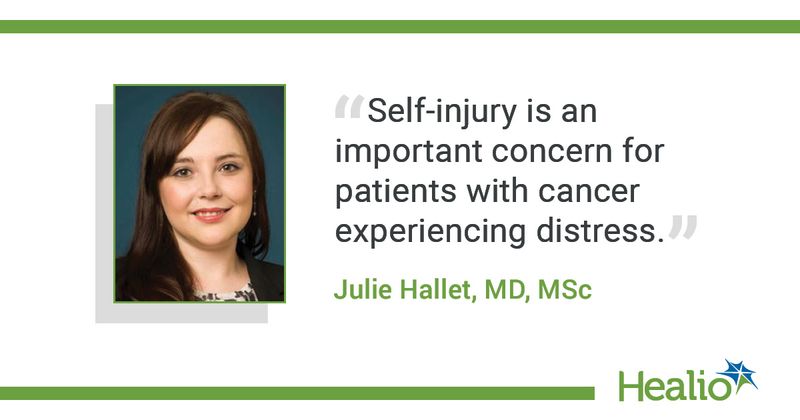Nonfatal self-injury more common than suicide after cancer diagnosis
Following cancer diagnosis, there was a higher incidence of nonfatal self-injury than suicide, according to a population-based, retrospective cohort study in JAMA Network Open.
“When studying patient-reported symptoms, our group observed that depression symptoms and distress were frequently reported by patients following a cancer diagnosis, but that very few of those patients received supportive interventions after reporting depressive symptoms or distress,” Julie Hallet, MD, MSc, of University of Toronto’s Temerty Faculty of Medicine and Dalla Lana School of Public Health, ICES and Sunnybrook Research Institute, told Healio Psychiatry. “One of the potential issues in providing supportive interventions after patients report depressive symptoms is the difficulty in identifying those patients most in need of supportive care to target the use of limited resources.”

Hallet and colleagues analyzed data for 806,910 adults (mean age, 65.7 years; 50.2% men) with cancer diagnoses between Jan. 1, 2007, and March 31, 2019, noting any nonfatal self-injury (NFSI) events after diagnosis, which would indicate “a severe manifestation of psychological distress and difficulty coping with cancer,” Hallet said.
During the study period, 352,050 patients (43.6%) died, with 182 (<0.1%) of those dying by suicide.
Researchers identified 2,482 NFSI events, with a median of 29 months between diagnosis and the event. A second NFSI event occurred in 49 patients (2%). Events were mostly related to medication poisoning (77.4%) or injury with a sharp object (10.6%). Of patients with an NFSI event, 10 died by suicide during follow-up.
Cumulative incidence of NFSI at 5 years was 10.2% (95% CI, 8.7%-11.7%) among patients with previous self-injury and 4.4% (95% CI, 3.9%-5%) among patients with previous inpatient severe psychiatric illness.
NFSI was strongly associated with history of severe psychiatric illness, adults younger than 39 years of age and previous self-injury. Patients with higher material deprivation and greater comorbidity burden also had a high NFSI risk.
Head and neck cancers, genitourinary cancer and hematologic cancer were associated with a higher NFSI risk compared to bronchopulmonary cancer. Advanced stage IV cancer was associated with a lower NFSI risk than stage I cancer.
“It is important to recognize that self-injury is an important concern for patients with cancer experiencing distress,” Hallet said. “It should be assessed and screened for, especially in groups at higher risk as identified in our study – younger patients, patients with prior psychiatric history and patients diagnosed with head and neck cancers.”
Limitations were inclusion of only more severe NFSI, differential misclassification bias, assumption that diagnosis date was when the patient became aware of diagnosis, non-assessment of certain potential risk factors and the introduction of medical assistance in dying legislation passed in Canada in 2016.
“Our goal is to help use this data to change practice so we can provide better tailored supportive care to patients,” Hallet said. “We are currently examining whether routinely screened patient-reported outcomes (routine symptoms scores reported by patients during clinic visits) can predict who is at higher risk of self-injury. This would help clinicians identify at-risk patients and provide them with supportive care. We are also looking at whether or not patients diagnosed with cancer have more frequent self-injury than similar individuals without cancer.”
